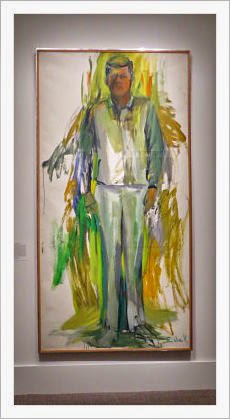 Elaine de Kooning (1918-1989), John F. Kennedy #21, 1963, Michael and Susan Luyckx
Elaine de Kooning (1918-1989), John F. Kennedy #21, 1963, Michael and Susan Luyckx
I've been twice in five days.
If you lived in a generation with the halcyon JFK administration and recall the verve, the energy, spontaneity, glamour, and intelligence the Kennedys brought to the White House, you will not want to miss the nine portraits and drawings which Elaine de Kooning
(1918-1989) drew of President Kennedy in 1963, some larger than life and now on display at the Smithsonian's National Portrait Gallery.
They are part of the major retrospective of Ms. de Kooning's
portraits which went up last week, coinciding with
Women's History Month and the artist's birthday on March 12.
President John Fitzgerald Kennedy sat for "Elaine" (the name the Portrait Gallery says she likely would have favored) at the "Winter White House" in Palm Beach, Florida in late 1962 and early 1963.
 At the National Portrait Gallery, Senior Curator Brandon Brame Fortune discusses Elaine de Kooning's John F. Kennedy, 1963. This work usually hangs at one of the National Gallery's entrances and is part of the museum's permanent collection, "America's Presidents."/Photo by Patricia Leslie
At the National Portrait Gallery, Senior Curator Brandon Brame Fortune discusses Elaine de Kooning's John F. Kennedy, 1963. This work usually hangs at one of the National Gallery's entrances and is part of the museum's permanent collection, "America's Presidents."/Photo by Patricia Leslie
Ms. de Kooning called President Kennedy "bigger than life....I was determined to...communicate his warmth, sharp wit, appraising glance, and something of the outdoor figure I saw." In the year after his death in 1963, the artist barely lifted a paint brush, and throughout her life, she kept the JFK portrait #21 (at the top of this page) which still belongs to her family.
How she came to be selected to paint the president's portrait makes fascinating reading in the de Kooning catalogue ($49.95), but, in a few words: If it were not for the Harry S. Truman Library, there might not be a JFK series by Elaine de Kooning. According to the library's executive director at the time, David D. Lloyd, she "obviously belongs in the new frontier of art," and she got the commission. (Later, Ms. de Kooning said it would take a while for President Truman to grow accustomed to her style since he was not a big fan of modern art.)
Pretty amazing stuff when one realizes she was competing against male artists in 1962. Not only was she a woman, but her style was unconventional and one might say extreme for a presidential library located in the Midwest.
Once it got wind of the library's interest in a Kennedy portrait, the White House went to work right away to accommodate Ms. de Kooning, and off to Palm Beach she went.
Of the portraits and drawings in the show, the Truman JFK is my least favorite. And why is that?
The whole thing is stilted and artificial. The background of bright yellows and oranges overshadows the subject who sits in the center with a puzzled expression as if to say: "Why am I here?" He appears uncomfortable, thinner, more timid than the person we have come to know, lacking his customary confidence and sex appeal but with a fire (the assassination?) about to engulf and shroud him, his expression and bearing make more sense.
Yellow is not a strong color. It's a weak color, especially compared to the vibrant and energetic greens and blues Ms. de Kooning used for the National Gallery's official JFK portrait that is part of the Gallery's series of presidential portraits. (She is one of two female artists represented in the series, the other, Greta Kempton, who, coincidentally, painted President Harry S. Truman!)
The year attached to the Truman painting is 1963. The catalogue has a photograph of President Truman with Ms. de Kooning at the presentation ceremony in 1965.
The color catalogue features the works in the show, naturally, and an entire section is devoted to JFK, and Ms. de Kooning's experience trying to paint a figure constantly in motion: "He was--well, he was just a great-looking man." And "incandescent, golden." (The yellows in the Truman JFK?)
Ms. de Kooning was an abstract expressionist, known for her stark, angular, and bright renditions of contemporary figures, usually men, who dominate the show.
"Men always painted the opposite sex, and I wanted to paint men as sex objects," the catalogue quotes her. (Rock on, Elaine!) She drew several men (Fairfield Porter, Johnny Snow) sitting with their legs spread, and when JFK drooped his leg over a beach chair and asked her "Is this pose all right?" Yes, it was! (Rock on, Elaine!)
The exhibition is not entirely about JFK, but that's who (or what) engulfs me. Three free films run continuously in a loop.
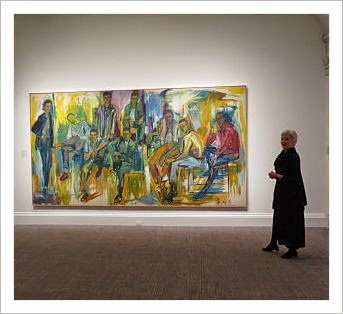 National Portrait Gallery Senior Curator Brandon Brame Fortune with Elaine de Kooning's The Burghers of Amsterdam Avenue, 1963, private collection. Loosely modeled after two Dutch paintings, both titled The Governors of the Kloveniersdoelen, one executed by Govert Flinck (1615-1660) in 1642 and the other by Bartholomeus van der Helst(1613-1670) in 1655, both on loan from the Netherlands to the National Gallery of Art where they may be seen at the Seventh Street, NW entrance to the ground level through March 11, 2017/Photo by Patricia Leslie
National Portrait Gallery Senior Curator Brandon Brame Fortune with Elaine de Kooning's The Burghers of Amsterdam Avenue, 1963, private collection. Loosely modeled after two Dutch paintings, both titled The Governors of the Kloveniersdoelen, one executed by Govert Flinck (1615-1660) in 1642 and the other by Bartholomeus van der Helst(1613-1670) in 1655, both on loan from the Netherlands to the National Gallery of Art where they may be seen at the Seventh Street, NW entrance to the ground level through March 11, 2017/Photo by Patricia Leslie
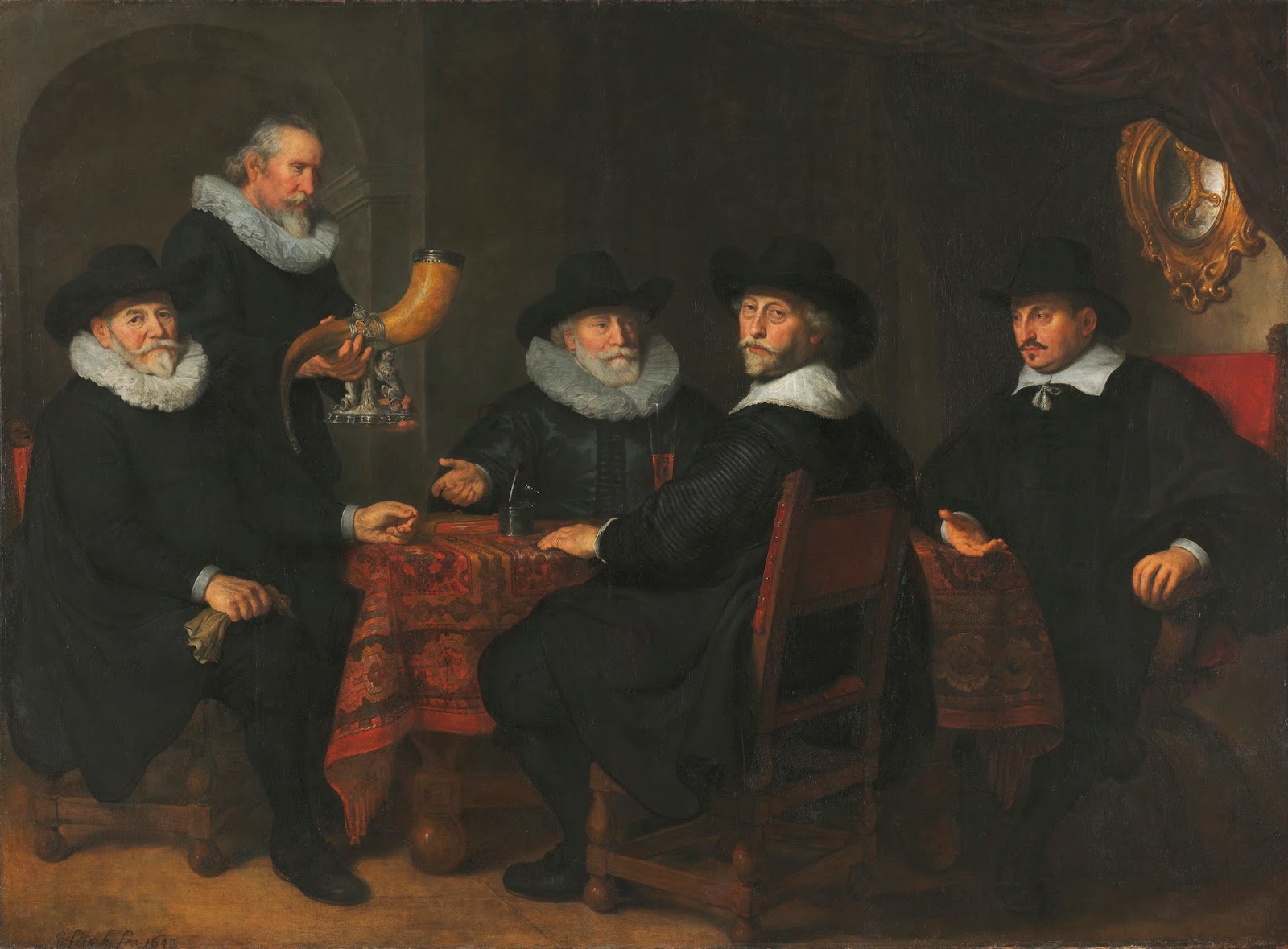 Govert Flinck, Dutch (1615 – 1660)
Govert Flinck, Dutch (1615 – 1660)
The Governors of the
Kloveniersdoelen, 1642, Rijksmuseum,
Amsterdam, on loan from the City of Amsterdam to the National Gallery of Art, Washington, D.C.
 Bartholomeus van der Helst, Dutch (1613 – 1670) The Governors of
the Kloveniersdoelen, 1655, Amsterdam Museum on loan to the National Gallery of Art, Washington, D.C.
Bartholomeus van der Helst, Dutch (1613 – 1670) The Governors of
the Kloveniersdoelen, 1655, Amsterdam Museum on loan to the National Gallery of Art, Washington, D.C.
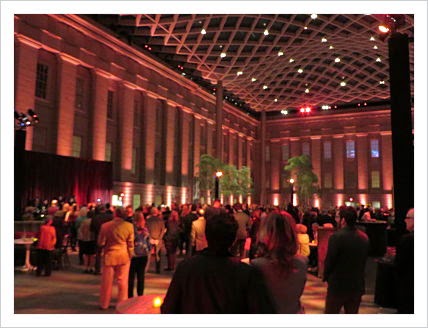 In the Kogod Courtyard at the National Portrait Gallery, there was "a party going on" to celebrate Elaine de Kooning's birthday March 12 and the opening of a major retrospective of her portraits/Photo by Patricia Leslie
In the Kogod Courtyard at the National Portrait Gallery, there was "a party going on" to celebrate Elaine de Kooning's birthday March 12 and the opening of a major retrospective of her portraits/Photo by Patricia Leslie
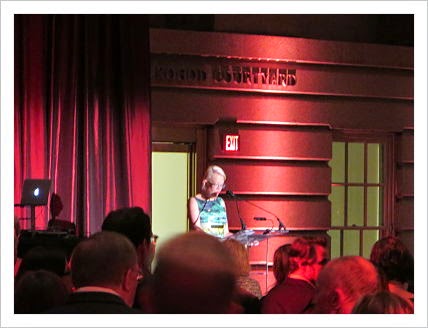 Kim Sajet, director of the National Portrait Gallery, welcomed guests to the reception for "Elaine de Kooning: Portraits." In a statement Ms. Sajet said the artist "ensured that a person's likeness was linked to their innate vitality and spirit." The Gallery holds the largest museum collection of Ms. de Kooning's portraits, and the new exhibition includes rarely seen works on loan from the artist's estate and from family members/Photo by Patricia Leslie
Kim Sajet, director of the National Portrait Gallery, welcomed guests to the reception for "Elaine de Kooning: Portraits." In a statement Ms. Sajet said the artist "ensured that a person's likeness was linked to their innate vitality and spirit." The Gallery holds the largest museum collection of Ms. de Kooning's portraits, and the new exhibition includes rarely seen works on loan from the artist's estate and from family members/Photo by Patricia Leslie
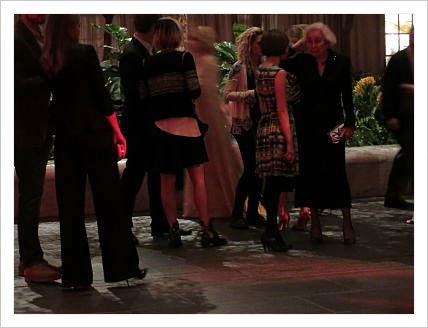 At Elaine de Kooning's birthday party March 12, 2015 at the National Portrait Gallery/Photo by Patricia Leslie
At Elaine de Kooning's birthday party March 12, 2015 at the National Portrait Gallery/Photo by Patricia Leslie
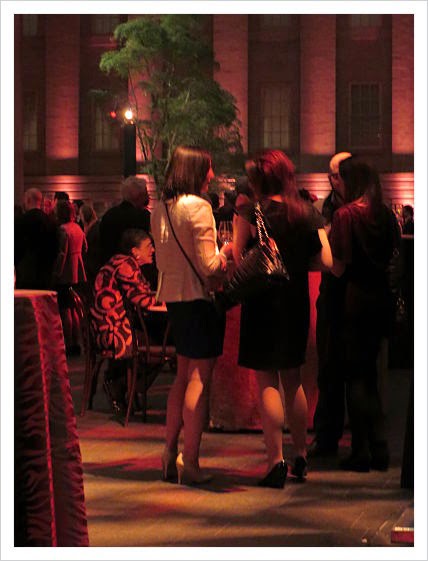 At Elaine de Kooning's birthday party March 12, 2015 at the National Portrait Gallery/Photo by Patricia Leslie
At Elaine de Kooning's birthday party March 12, 2015 at the National Portrait Gallery/Photo by Patricia Leslie
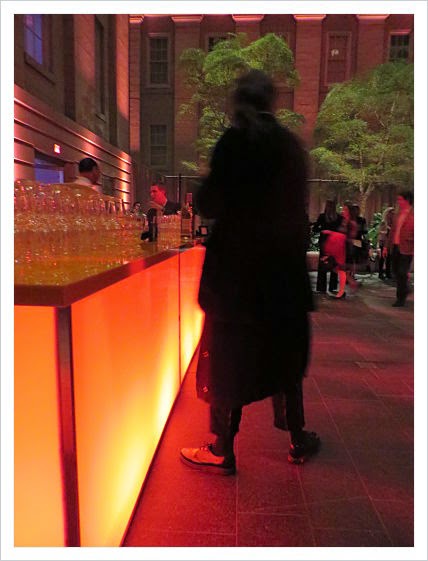 A man in black (subject for the artist?) at Elaine de Kooning's birthday party March 12, 2015 at the National Portrait Gallery/Photo by Patricia Leslie
A man in black (subject for the artist?) at Elaine de Kooning's birthday party March 12, 2015 at the National Portrait Gallery/Photo by Patricia Leslie
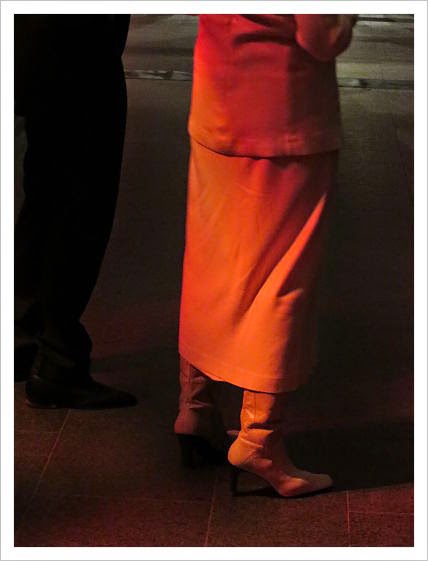 At Elaine de Kooning's birthday party March 12, 2015 at the National Portrait Gallery/Photo by Patricia Leslie
At Elaine de Kooning's birthday party March 12, 2015 at the National Portrait Gallery/Photo by Patricia Leslie
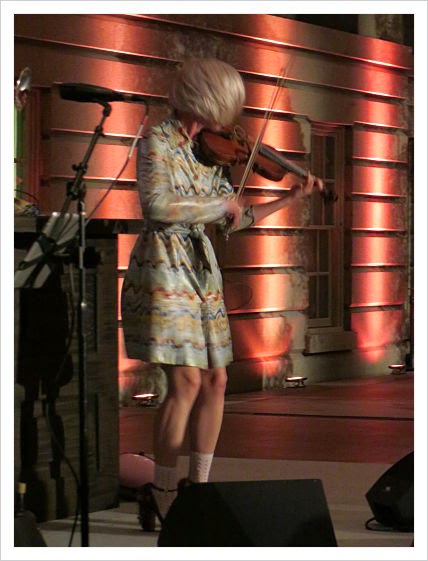 The Dolls, and Sean Lane and the Bay Jazz Project made music at the Elaine de Kooning party at the National Portrait Gallery, and this energetic gal with a bobbing head slashed her fiddle with a force to stun and silence the crowd/Photo by Patricia Leslie
The Dolls, and Sean Lane and the Bay Jazz Project made music at the Elaine de Kooning party at the National Portrait Gallery, and this energetic gal with a bobbing head slashed her fiddle with a force to stun and silence the crowd/Photo by Patricia Leslie
 William Wordsworth would have been proud of these golden daffodils at Elaine de Kooning's birthday party March 12, 2015 at the National Portrait Gallery. The colors match the yellows in Ms. de Kooning's JFK portrait on loan from the Harry S. Truman Library in Independence, Missouri/Photo by Patricia Leslie
William Wordsworth would have been proud of these golden daffodils at Elaine de Kooning's birthday party March 12, 2015 at the National Portrait Gallery. The colors match the yellows in Ms. de Kooning's JFK portrait on loan from the Harry S. Truman Library in Independence, Missouri/Photo by Patricia Leslie
What: Elaine de Kooning: Portraits
When: Now through January 10, 2016. The National Portrait Gallery is open from daily from 11:30 a.m. - 7 p.m.
Saturday, March 21, 2015, 11:30 a.m. to 3 p.m.: Women's History Month Family Day, Kogod Courtyard
Friday, April 17, 2015, 12 p.m.: "In Her Own Light: Liz Rideal on Elaine de Kooning." Ms. Rideal from the National Portrait Gallery, London, is the author of How to Read Art (2015), and she will lead a tour of the de Kooning show.
Where: Smithsonian National Portrait Gallery, 8th and F streets, N. W., Washington, D.C. 20004
How much: No charge
For more information: 202-633-1000 or visit the web site
Metro station: Gallery Place-Chinatown or walk 10 minutes from Metro Center
patricialesli@gmail.com
.jpg)






































